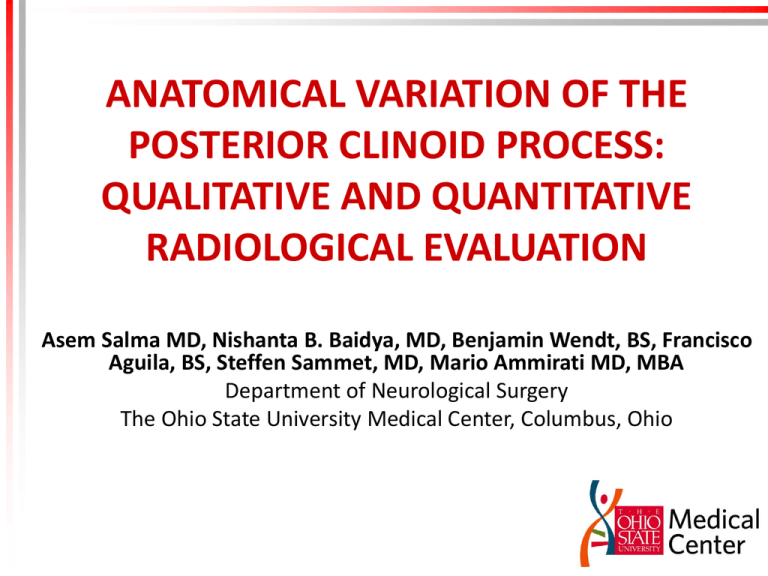Microscopic and endoscopic anterior communicating artery complex
advertisement

ANATOMICAL VARIATION OF THE POSTERIOR CLINOID PROCESS: QUALITATIVE AND QUANTITATIVE RADIOLOGICAL EVALUATION Asem Salma MD, Nishanta B. Baidya, MD, Benjamin Wendt, BS, Francisco Aguila, BS, Steffen Sammet, MD, Mario Ammirati MD, MBA Department of Neurological Surgery The Ohio State University Medical Center, Columbus, Ohio Disclosures • Nothing to disclose Background • Surgical management of interpeduncular fossa lesions such as basilar tip aneurysms and retrochiasmatic craniopharyngiomas is challenging due to the complex neuro-vascular relationships of this region. In addition, the presence of the posterior clinoid process (PCP) complicates neurosurgical approaches to this area. • Awareness of the anatomical variations of the PCP and of its relationship to other skull base landmarks could help in safe surgical access, both open and endoscopic, of the retrosellar region. Purpose To investigate the anatomic variations of the posterior clinoid process from the radiological perspective. Materials & Methods • We evaluated the radiological anatomy of the posterior clinoid process region on thirty six, 3D reconstructed, computerized tomography scans of the cadaveric heads by using TeraRecon software (TeraRecon, Inc., San Mateo, California, USA). • The anatomical variation of the PCP was studied, and we measured the distances between the lateralmost extension of the PCP and different anatomical landmarks in the skull base such as the posterior border of the crista galli (CG), the middle point of basiocciput (BO) at the level of the foramen magnum (FM), the superior orbital fissure (SOF), the foramen rotundum (FR) and the foramen ovale (FO). Figure 1 and figure 2. Fig. 1. 3D reconstructed CT of the skull base anatomy. Base of the crista galli, CG; anterior clinoid process, ACP; posterior clinoid process, PCP; foramen ovale, FO; middle point of basiocciput at the level of the foramen magnum, BO. Fig. 2. Colored lines with labels showing how the measurement from each PCP has been taken. A, distance between PCP and CG; B, distance between PCP and ACP; C, distance between PCP and SOF; D, distance between PCP and FR, E, distance between PCP and FO; F, distance between PCP and BO. (“r” for right, “l” for left). SOF, superior orbital fissure; FR, foramen rotundum. Results Qualitative Analysis • The study revealed a considerable variation in the gross anatomy of the posterior clinoid process. • Two specimens did not have the dorsum sella and hence the PCPs were absent (Figure 3a). Fig. 3a. The dorsum sella (DS) and PCP are missing. Fig. 3b. Normal anatomy. • In one specimen the ACPs and PCPs were connected with each other on the right side (Figure 4). • In two specimens the ACPs and PCPs were connected with each other on both sides (Figure 5 and figure 6). Fig. 4. 3D reconstructed CT of the skull base. The arrow showing the fused ACP and PCP on the right side. Fig. 5. 3D reconstructed CT of the skull base, right superolateral view. The arrows show the fused ACPs and PCPs on both sides. Fig. 6. The arrowheads point to bilaterally fused ACPs and PCPs. Quantitative Analysis • In the remaining 31 specimens we were able to measure the distances between the posterior clinoid process and the selected skull base structures discussed in the Material and Methods section. These results are shown in Table 1 and table 2. Anatomical Landmarks Mean± SD Maximum Median (All distances are in mm) From the base of the CG to the PCP Right Left 45.14±4.0 46.24±4.5 58.16 57.49 45.21 46.34 36.14 35.40 From the PCP to the middle point of the BO at the level of the FM Right Left 40.41±5.1 41.0±5.2 47.83 47.99 40.64 40.50 27.52 28.57 Table 1. The table shows the values for the measurements of the distance between the PCP and the base of crista galli (CG) anteriorly, and the middle point of the basiocciput (BO) at the level of the foramen magnum (FM) posteriorly. SD, standard deviation. Minimum Anatomical Landmarks Minimum Mean±SD Maximum Median (All distances are in mm) Distance between the anterior and posterior clinoid process Right Left 12.03±3.18 12.11±2.77 24.30 20.09 12.08 12.20 8.9 7.89 Distance between the lateralmost extension of the right PCP and the right SOF FR FO 21.40±4.46 19.10±4.37 22.02±3.41 30.22 28.28 29.76 21.39 18.92 22.06 11.86 14.06 16.06 21.75 20.72 22.36 15.93 13.43 16.84 Distance between the lateralmost extension of the left PCP and the left SOF 21.83±3.4 32.75 FR 20.73±3.7 28.13 FO 22.42±3.43 30.32 Table 2. The table shows the values of the measurements of different anatomical structures in relation to the posterior clinoid processes (PCPs). SOF, supraorbital fissure. FR, foramen rotundum. FO, foramen ovale. Conclusions • The unique location of the posterior clinoid process at the center of the skull base can be used as a landmark for pre-surgical planning in surgeries of the clinoid region. Therefore, knowledge of many variations of the posterior clinoid process is crucial for the execution of surgical maneuvers involving the posterior clinoid process. • All the above information can be obtained preoperatively using the 3D reconstructed CT image.







